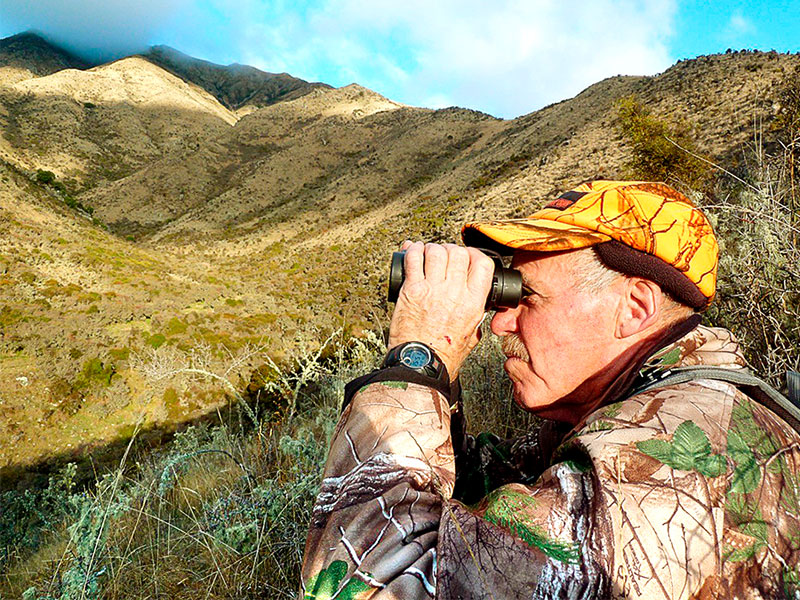Wait and watch: a lesson in game hunting
4 min read
Take plenty of time to sit still and watch with a good pair of binoculars. Photo: Tony Orman
Many years ago – somewhere in the early 1960s from memory – the late John Henderson and I climbed up onto the tops of the Tararua Range behind Ōtaki to Kime Hut.
It was evening when we arrived and that night, the weather turned to the south. The southerly lashed the Tararuas for two days with bitterly cold winds and driving rain but on the second night, it blew itself out.
The next morning, the rising sun highlighted the glistening wet tussock and the morning settled into a still, crisp but sunny one.
I was keen to push on towards Mt Hector, but John urged us to sit down and have a look about. And so, we did, glassing the slopes that fell away to the sub-alpine leatherwood belt. We spotted a dozen deer in an area I would have hurried by.
It was a lesson that I’ve always remembered but I must confess I have too often, lapsed and temporarily forgotten it since. But every so often, the message is driven home to me to sit and watch.
I keep getting reminded of it, usually by my Labrador. You see, dogs have unusually good vision when it comes to spotting movement, far better than ours. So often, the Labrador has spotted a deer or pig before me – and I’ve had the binoculars, not the dog!
A dog can pick up any animal movement, no matter how slight it is; a deer is much superior to a dog’s visual skill. Pigs have relatively poor eyesight but have acute hearing and that indefinable sixth sense.
Respect the ability of a deer to spot the slightest movement and at surprising distances. Dr Fraser Darling, in his classic book A Herd of Red Deer, wrote (reprint 1956): “The sight of deer is exceedingly acute to movement up to long distances and in this way, they are superior to most men.”
Yet deer do not identify by sight a stationary object such as a still hunter. A human is probably better equipped visually to recognise a completely still object.
Leonard Lee Rue III in his book The Deer of North America, wrote, “A deer’s vision is geared to detect motion. Motionless objects, even if they do not blend with their surroundings, are seldom seen, and if seen are seldom recognised.”
In an article in a UK shooting and hunting magazine, Dr Andrew Allen explained the incredible sense of sight of deer, particularly on movement.
“So long as everything around it remains still, the deer sees almost nothing at all,” he wrote. “Beyond 20 yards (metres), it cannot distinguish a stationary man from a lamp post.”
Yet deer – and a dog – have much superior vision to humans in poor light such as dawn and dusk.

Another aspect to note is that most ‘camo’ fabrics have brighteners built in, and it is that UV luminescence deer can pick out. Ordinary clothes detergents also contain brighteners but swapping it with UV removing wash products is an easy fix.
What about the converse, i.e., the hunter’s ability to see deer?
A study in New Zealand’s Nelson Lakes National Park by a Forest and Range Experimental Station project emphasised the importance of sitting and looking. The researchers studied deer in an alpine catchment over a 2000-hour period.
Assuming an observer has a pair of good binoculars and is relatively well hidden, they can expect to see 37% of a deer population in any three-hour period of scanning alpine grasslands.
Think about it: in three hours, the probability is you’ll see less than 40% of the deer.
The researchers found that after three three-hour scans – nine hours in all – the hunter’s chances of seeing a deer increased from 37 to 75%. After six, three-hour scans – 18 hours in all – the chances rose to 94%.
But we don’t have 18 hours to sit in the one place looking through binoculars. But even just sitting and scanning for 20 minutes or half an hour will often pay dividends.
Read more: Pro hunting tip: think like a deer in winter
Read more: What’s in your hunting pack?
Read more: Hunting big gnarly boars
Most hunters move too much and too fast. Unless the terrain is open and devoid of cover for animals, deer can be browsing behind a shrub. Pigs, being much lower to the ground, can be hard to spot even in open tussock country.
Often, I have picked an advantage point to sit and watch for a deer or pig. When after perhaps 10 minutes, I have spotted a deer, I watch it and then as it feeds, it moves behind a cover. Had I just arrived and sat down at that moment, I would not have seen it and consequently, would’ve assumed there were no animals there. But having seen the deer five minutes previously, even though it had inadvertently moved behind cover, I knew it was there.
What I’m trying to say is don’t be content with just a minute or two of watching. Spend 10 or more minutes – or even more – looking. Because once you move, the deer’s exceptional vision will see you. And that means game over. The deer has won – or rather you just lost by being too impatient.



